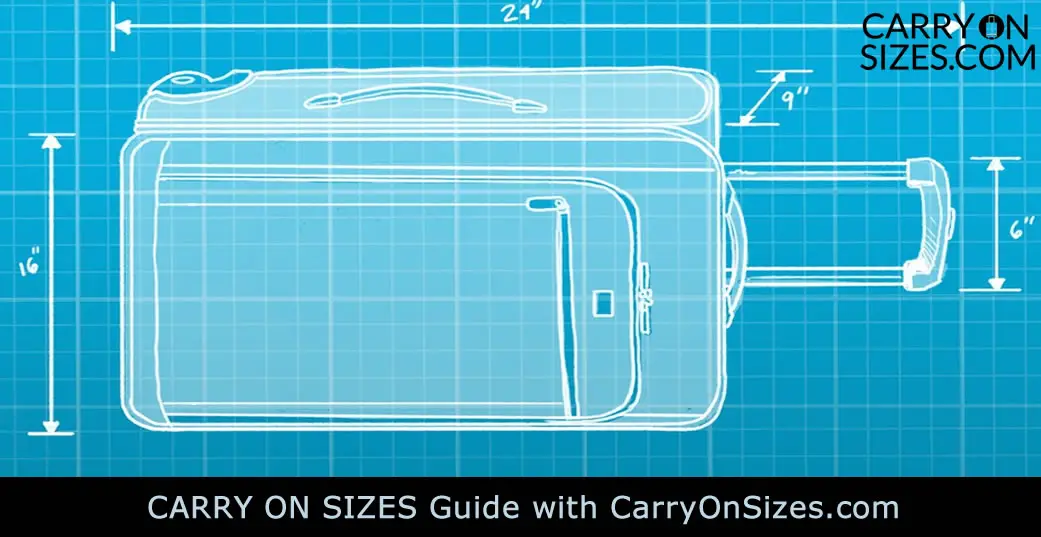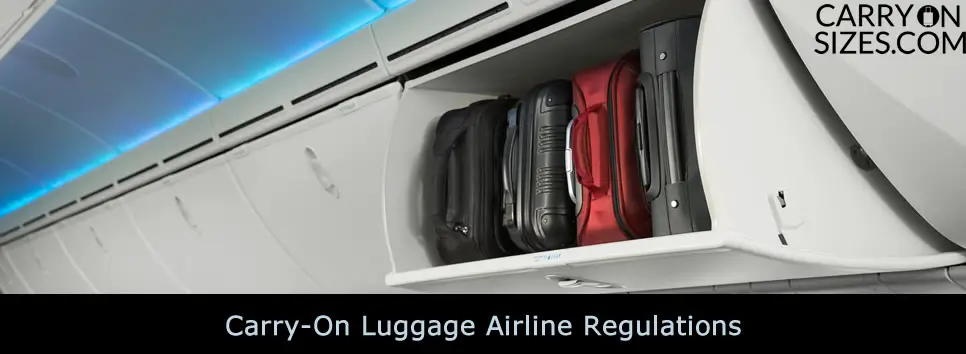What is Carry on Baggage?
By definition, carry-on baggage is “small or compact enough to be carried aboard and stowed on an airplane, train, or bus by a passenger”.
Most people who know the word carry on or have used a carry-on typically use them by way of airplane for 2-4 day trips.
A carry-on bag is typically one that you carry onto the plane and store in the overhead bin. All airlines and planes have different requirements and restrictions as to what sizes are allowed, what the maximum weight allowed it as well as what can be carried in the bag.
Domestic airplanes typically provide a larger size to be allowed in comparison to international airplanes (we’ll get more into that later).

Important Carry-on Rules to Know
There have been carry-on luggage restrictions in place now for many years. Yet as everyone who travels at all knows, invariably somebody shows up at the gate with the most outrageous carry-on bags expecting to have no problems taking them on board.
In all fairness it is hard to keep up with all the changing rules of what you can take on board, or thru security check-points along with all the size and weight restrictions that now exist. Unless you travel regularly you can easily find some new rule has gone into effect causing last minute hassles with your luggage.
Carry On Baggage Tips
All air carriers have established rules for carry-on luggage, but unfortunately they are all not the same. So what are you supposed to do? Well our recommendation is to go with the lowest common denominator (the most restrictive rules) as a guide. That way you’re going to be safe – until they change the rules.
When you think about it, the limits on carry-on luggage make sense. Overhead and under seat storage space is limited. Depending on the type of aircraft and the particular airlines configuration it can be almost nonexistent. Most regional carriers flying small jets or prop aircraft allow only a briefcase or purse on board. Larger carry-on items must be gate checked. The good news is you don’t have to pay a baggage charge for these items and they usually can be claimed plane side at your destination eliminating the baggage claim hassle.
One of the problems that you often run into is there are many different overhead storage configurations even on the same airline. Unless the airline flies all the same type airplanes like Southwest Airlines which flies all B737 type aircraft, they can have different size overhead storage bins. It’s not uncommon for your bags to fit nicely on one flight and not on another.
Don’t forget – how you pack your carry-on can also be the difference between what will be allowed or fit in the overhead bins and what won’t. It’s convenient that many bags have expandable compartments on the outside of the bag. But don’t stuff them with every last minute thing you can think of. I’ve done that with all kinds of newspapers and books I’ve picked up at the airport. I get on the plane and the bag will never fit in the overhead bin. Now you’re faced with taking all that stuff out or checking the bag.
Carry On Luggage Airline Regulations

Recently, airlines have become much stricter enforcing their carry-on luggage size requirements.
Previously, airlines measured the size of the actual bag (not including the wheels).
Now, airlines are measuring from the floor to the top of the bag, including the wheels and handle, effectively tightening the restrictions and rendering older carry-ons too large.
Today, most domestic airlines in the United States allow carry-ons up to 22” by 14” by 9,” for a total of 45” linear inches. Many international flights have even tighter restrictions allowing bags sized only 42” linear inches or smaller. These dimensions do not apply to all airlines.
Some airlines have dimensions slightly larger, or slightly smaller, so it is extremely important to check with the airline before using a bag as a carry-on.
Carry on Personal items
Most airlines allow one carry on bag and one extra personal item. A personal item should be stored under the seat in front of you and usually they allow items like:
- a shoulder bag
- or a backpack
- or a laptop bag
- or a briefcase
- or a camera
- or a diaper bag
- or an other small item
Besides the one carry on and one personal item most airlines allow you to bring the following items on the plane:
- Overcoat or wrap
- Umbrella
- A reasonable amount of reading material
- A collapsible wheelchair
- Child restraint seat meeting FAA approval standards
- A limited amount of duty-free merchandise or food purchased in the airport
- Assistive devices (a cane, one set of crutches, prescription medications and any medical devices needed to administer the medications, a portable oxygen concentrator (POC), etc.
Carry on Size & Weight Allowance by Airline
We have tried to compile a list of the airline carry-on baggage rules from a number of carriers. We try to keep this updated but it is always best to check with your specific carrier for the latest information if you have any questions. The most common maximum size for a carry-on bag seems to be 22 x 14 x 9 inches or 45 linear inches (L+H+W). Some airlines specify a maximum weight for a carry-on bag and some do not. But then you’re the one that has to lift it into the overhead bin so do your back a favor.
Below we have provided a breakdown of most major airlines and their carry-on restrictions.
Although we update this periodically, please be sure to check with the airlines for their most up to date restrictions and fees.



















 Qantas Airways Carry On Size Guide
Qantas Airways Carry On Size Guide






